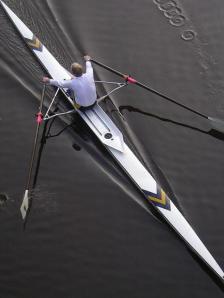I can’t imagine a rowing club without single sculls. If you join a rowing club as a junior (under 18) you will be using these boats almost immediately and generally speaking the most confident single scullers learned as juniors.
As an athlete, the single sculler lives in a slightly different world from the crew rower. Whether in training or competition, they work alone, entirely dependent on their own resources and motivation. Single sculling has a lot in common with solo track events like running and cycling. Of course, most single scullers also happily scull or row in crew boats, but anyone who has sculled in a single knows that it offers a new dimension to the sport.
There are two slightly different styles of sculling, which if you look closely you’ll probably see examples of on a river or lake near you. Scullers who have learned as juniors often worry a lot less about the amount of roll (rotation around the long axis of the boat) they create. They simply absorb the rolling movement with their lower body while their upper body remains stable and gets on with the bladework. They look as as if they have a very sophisticated and responsive suspension system built into their hips – as in fact they do – which absorbs the rolling motion and isolates it from their upper bodies. People who have learned as adults tend to be stiffer and less relaxed about rolling. They use their core muscles to sit the boat level which produces a more elegant stroke – although they rarely look as carefree as the early learners.
As a coach, I personally think that the pursuit of elegance, while a good guide in 99% of rowing and sculling technique, has to take second place to the carefree, instinctive movement of a happy, relaxed single sculler. The amount of energy lost in the slightly untidy rolling motion they produce is tiny and there is a risk that coaching their flexibility out of them could do more harm than good. This can create issues however when a flexible single sculler sits in a double with a more conventional sculler who may not be happy with the same level of instability.
Adaptable as singe scullers often are, matching the sculler to the boat is important and it is a good idea to match the weight classification and rigging setup of the boat to suit the individual sculler as far as one can, even with club boats used by many different scullers.

